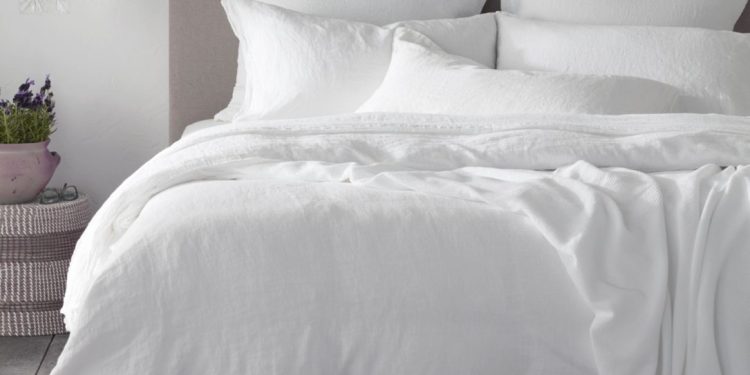Linen bed linen has gained significant popularity in recent years, as more people recognize the numerous benefits and qualities associated with this natural fabric. Apart from this, linen bed linen, derived from the flax plant, boasts a rich history and unique qualities that set it apart in the world of bedding. Known for its exceptional breathability, linen ensures a comfortable sleep experience by regulating temperature and wicking away moisture, making it ideal for all seasons. Its durability is unmatched, with linen bedding becoming softer over time, offering a lasting investment. The fabric’s natural luster and textured surface provide a timeless aesthetic that complements various interior styles. Beyond its luxurious feel, linen bed linen is hypoallergenic, resistant to dust mites, and environmentally sustainable due to flax cultivation’s minimal impact. Proper care, including gentle washing and line drying, ensures longevity and preserves the fabric’s elegance. Elevate your sleep experience with linen bed linen – a combination of comfort, durability, and timeless sophistication.
In this comprehensive exploration, we will delve into the origins of linen, its unique characteristics, the advantages of using linen bed linen, and practical tips for care and maintenance. By the end of this discussion, you will have a thorough understanding of why linen bed linen is considered a luxurious and worthwhile investment for your sleep sanctuary.
1. The Story of Linen
Linen, a textile derived from the flax plant, has a rich history that dates back thousands of years. Its use can be traced to ancient civilizations such as Egypt, where linen was considered a symbol of purity and luxury. The process of transforming flax fibers into linen involves intricate steps, including harvesting, retting, spinning, and weaving. This labor-intensive process contributes to the fabric’s exclusivity and high-quality reputation.
2. Characteristics of Linen: Nature’s Gift to Bedding
Typically, linen bed linen possesses a distinct set of characteristics that sets it apart from other textiles. One of its key features is breathability. Linen fibers allow air to circulate freely, providing a cooling effect that is especially beneficial during warmer seasons. This breathability also helps in moisture absorption, keeping the sleeper dry and comfortable throughout the night.
Additionally, linen is renowned for its durability. The fibers are exceptionally strong, and linen bedding tends to become softer and more comfortable with each wash. This longevity contributes to the sustainability of linen products, as they are less prone to wear and tear compared to other materials.
Another notable quality of linen is its natural luster. The fabric has a subtle sheen that adds an elegant touch to any bedroom. Linen’s smooth and textured surface gives it a timeless aesthetic that complements various interior styles, from modern to classic.
3. Advantages of Linen Bed Linen: A Luxurious Investment
Comfort and Breathability: Linen’s breathability ensures a comfortable sleep experience by regulating temperature and wicking away moisture. This is particularly advantageous for hot sleepers or those living in warmer climates.
Durability and Longevity: Linen bed linen is an investment in quality. Its durability means that it can withstand the test of time, providing a lasting and reliable addition to your bedding collection.
All-Season Appeal: Linen’s ability to adapt to different temperatures makes it suitable for year-round use. It keeps you cool in the summer and retains warmth during colder months, offering versatility in all seasons.
Hypoallergenic Properties: Linen is naturally hypoallergenic and resistant to dust mites, making it an excellent choice for individuals with allergies or sensitive skin.
Environmental Sustainability: The cultivation of flax, the plant from which linen is derived, requires fewer pesticides and water compared to other crops, contributing to linen’s eco-friendly profile.
4. Care and Maintenance of Linen Bed Linen: Preserving Eleganc
To maximize the lifespan of your linen bed linen and maintain its luxurious feel, proper care is essential. Here are some practical tips:
Washing: Machine wash your linen bed linen in cold water with a gentle detergent. Avoid using bleach as it may weaken the fibers. Line drying is recommended, but if using a dryer, choose a low heat setting to prevent excessive wrinkling. Ironing: Embrace the natural wrinkles of linen, or if you prefer a crisper look, iron while the fabric is slightly damp. Use a medium to high heat setting.
Storage: Store your linen bed linen in a cool, dry place. Avoid plastic containers, as linen benefits from air circulation. Proper storage helps prevent mildew and preserves the fabric’s freshness.
Rotate Linens: To ensure even wear, consider rotating your linen bed linen collection. This practice extends the life of individual pieces and maintains a consistent appearance.
Conclusion In conclusion, linen bed linen is a luxurious and practical choice for those seeking a premium sleep experience. From its ancient origins to its modern appeal, linen’s unique characteristics, including breathability, durability, and natural elegance, make it a standout fabric in the world of bedding. The advantages of investing in linen bed linen extend beyond mere comfort; they encompass environmental sustainability, hypoallergenic properties, and timeless aesthetics.








